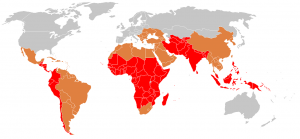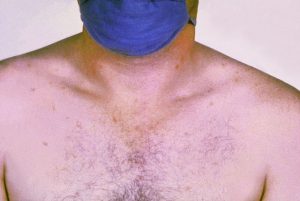Typhoid fever is a very common clinical presentation throughout Pakistan. Typhidot test is a rapid diagnostic test to diagnose typhoid fever.
Despite its low sensitivity (70%) and low specificity (40%), it is still a widely used test throughout the country.
People are being labeled as having typhoid fever based on a positive Typhidot test without symptoms and signs of typhoid fever. Here we’ll review briefly typhoid fever and Typhidot test.
How can a person get Typhoid fever?
Typhoid fever is also known as enteric fever. It is a disease of the developing countries like Pakistan and other south Asian countries and Africa. The estimated incidence in travelers to the endemic area is 3 – 30 cases per 100000 visitors each year.

The spread of the organism occurs in environments with poor sanitation and where consumption of unhygienic food items especially street items are consumed by people, mostly children and young adults.
The classic disease syndrome is caused by Salmonella Enterica serotype Typhi.
Other serotypes include salmonella Paratyphi A, B, C, and Choleraesuis.
Salmonella typhi can reside in the biliary tract (gall bladder) and be excreted for years after the acute infection.
This is termed as a chronic carrier state. In fact, typhoid fever was termed after the first carrier state was identified in an Irish-American cook, Typhoid Mary, blamed for infecting many of her clients.
Studies have also attributed an association of hepatobiliary (liver and gallbladder) cancer with the chronic carrier state of enteric fever.

Symptoms of Typhoid Fever:
Depending on the number of bacteria ingested, the incubation period varies from 5 to 21 days.
The classic presentation of Typhoid fever:
In the first week of the disease, typhoid bacteria enter the host bloodstream (bacteremia) and the patient develops a fever.
Fever in typhoid fever is described as a stepladder fever.
A stepladder fever means that the person has a 99F fever for a day or two followed by 100 F the next two to three days followed by 101F and so on.
This is like climbing a ladder or stairs. The fever is associated with chills and rarely rigors.
Contrary to other febrile states, the pulse rate remains normal or only slightly increases. This is also called relative bradycardia.
In the second week, the patient develops abdominal pain and constipation or diarrhea and a rash more marked on the trunk called rose spots.

In the third week, Patients liver and spleen enlarge and abdominal pain increases. Patients may develop intestinal perforation (marked by blood in stools) and peritonitis.
In the fourth week, patients may become septicemic and die or resolution of symptoms starts and the patient starts improving.
Because of the inappropriate use of antibiotics, complications related to enteric fever are rarely seen nowadays. Percentage of deaths from typhoid fever have declined tremendously after the antibiotic era and the mortality rate is currently less than 1%.
Other clinical manifestations:
Since enteric fever is caused by a bacteria, it can involve any sytem apart from the primary and most commonly involved gastrointestinal system.
Patients can develop a headache, altered sleep pattern, abnormal perception and psychosis, rigidity and brain infection (meningitis).
Patients may become confused, irritable and lose consciousness. This is termed as typhoid encephalopathy.
Patients may develop cholecystitits (inflammation of the gall bladder and biliary channels), pneumonia, osteomyelitis, and hepatitis.
Salmonella osteomyelitis is most commonly seen in sickle disease patients

How to diagnose Typhoid fever?
Diagnosis is based mainly on the clinical features and positive blood cultures. Culture positivity ranges from 40 to 80%.
Bonemarrow culture is the most sensitive test. Urine and stool culture may also be positive but has less sensitivity.
Relapse: when the patient is treated and cured of typhoid fever, he/she may develop typhoid fever again after two to three weeks.

Prevention of Typhoid fever:
Since the disease is acquired after the ingestion of contaminated food or water, the primary prevention of typhoid fever is to consume hygienic food, wash hands with soap and water after defecation and to acquire immunity via regular vaccination.
Three types of typhoid vaccines are currently recommended by the WHO.
- An injectable typhoid conjugate vaccine (TCV): Licensed for children from 6 months of age and adults up to 45 years of age;
- An injectable unconjugated polysaccharide vaccine: For persons aged two years and above; and
- An oral live attenuated Ty21a vaccine in a capsule formulation: For those over six years of age.

What is the importance of a positive Typhidot test:
Typhoid test is an antibody-based rapid diagnostic test. Patients with clinical features of typhoid fever and a positive Typhidot, this test may be useful but should never be interpreted alone.
In a study in Karachi, the test was found to have a positive predictive value of only 7.4%. this means in 100 patients with typhoid fever confirmed on blood cultures, only 7 patients had a positive Typhidot test.
In contrast, the negative predictive value of this test was found to be 87.9%. A high negative predictive value is suggestive of the test being truly negative (truly negative in 89 out of 100 patients).
This means we can perform the test and confidently exclude enteric fever from our differential diagnosis if typhidot is negative.

Diseases like Typhoid fever in which Typhidot can be falsely positive:
Malaria can have a similar presentation as enteric fever and a positive Typhidot test.
Similarly, upper respiratory tract infections, tuberculosis, urinary tract infections, dengue fever, pneumonia, gastroenteritis and autoimmune rheumatic diseases like rheumatoid arthritis can all present with fever and a positive Typhidot.
Book your appointment if you have a fever and a positive Typhidot
